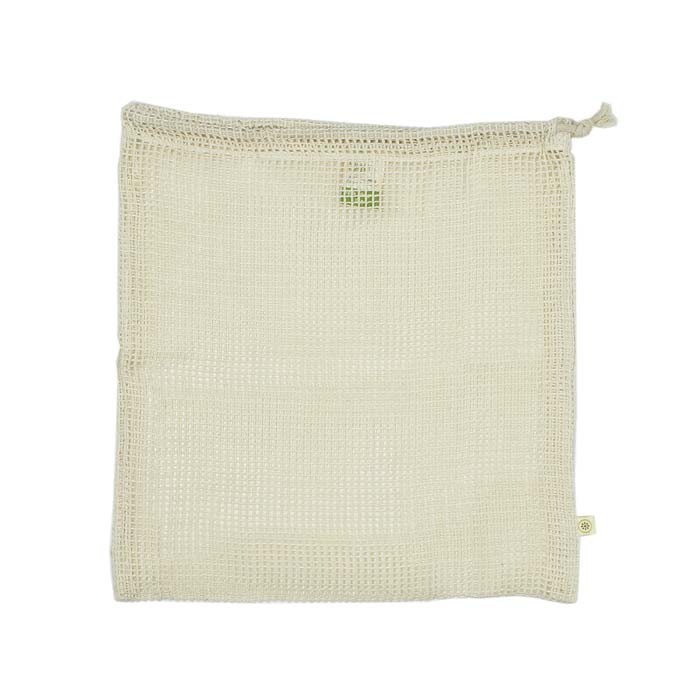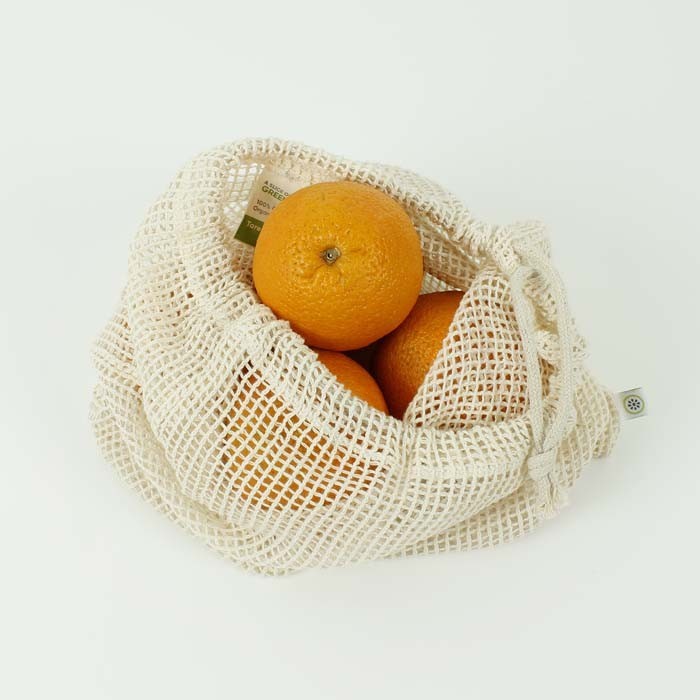We have tried many different methods and products, to reduce the amount of wrapped goods during a regular grocery shopping tour. It requires mindfulness and discipline, but eventually we were able to do a shopping with zero wrapping. This has now basically become our goal for every daily shopping tour [1]. So here is a bunch of tips on how to reduce the amount of packaging to the minimum during grocery shopping, based on our own personal experience.
-
Preventing—Be proactive
- Bring your own shopping bag The easiest yet most effective step was to simply bring our own bags for shopping, rather than using the free plastic bags offered in the grocery shop. We love Furoshiki or a simple backpack for that. Formerly we would have used the disposable plastic bags for a spontaneous shopping stop, unprepared and unequipped with a proper bag. Later we just started to bring Furoshiki everywhere, and even keep some at work, in the car or in the stroller.
- Self-checkout Being able to self-scan and self-checkout has quite facilitated the zero-wrapping shopping. We are now able to spread our Furoshiki in the shopping basket or hang it in the shopping cart, and simply scan and pack all products right away. There’s no need anymore to unpack and repack everything again at the checkout, which can be quite cumbersome with loose mushrooms on the counter belt.
- Create a shopping list Create a list of everything that you need, prior to your shopping trip. Only buy what’s on the list and do not get tempted by fancy packaging and sales.
- Bring your own containers Bringing your own container is possible in many shops and saves a lot of unnecessary wrappings. It’s usually better to tell the vendors ahead, since they tend to be pretty swift with their paper or plastic wrappings.
- A plastic or glass box for meat at the butcher or the meat section within the grocery shop. The weight scale can always be re-calibrated to zero, so multiple different meats can be combined in the same container.
- A bee wax towel (e.g. Abeego) works wonderful for cheese in the dairy or the cheese section within the grocery shop.
- A glass bottle for raw milk in the dairy. Anyway raw milk beats boiled milk by far in terms of healthiness.
- An empty egg box for eggs at the farmers market or in the dairy. Even Migros has an open egg section.
- A wooden basket works pretty well at the farmers market for loose vegetables.
- Bread from the bakery can also easily be wrapped in a Furoshiki.
- Flatbread wraps well in a Furoshiki or two large Abeego. Fresh turkish flatbread (dürüm) can be purchased at a local Kebab shop, and is much fresher than the ones from most grocery shops, which are usually full of conservatives.
- An empty glass bottle is great for oil or vinegar from the oil shop such as Vom Fass.
- Self-brought plates or containers and cutlery usually also work for buying food at a food stand, you might get some funny looks though.
- Bring along snacks and beverages Whether you go hiking, biking or simply walking around the lake, it is always good to have some snacks and beverages at hand. Otherwise we usually end up buying snacks and drinks from the next shop, and they rarely come without a wrap.
-
Adapting—Change your eating and shopping habits
- Reduce processed foods Many foods that are processed, such as canned food, microwavable meals, etc. are usually very generously packaged. Raw food on the other hand is available as is. By adapting a vegan or raw diet, you can save tons of packaging.
- Drink tap water In Switzerland the tap-water has a fairly high quality, very clean and with lots of minerals. Drinking tap water rather than bottled beverages in not only much healthier, but also saves a lot of plastic waste.
- Support local shopping Local shops that sell local products usually have less packaging, since the goods do not needed to travel very far. Some examples are the local farmers market, the cheese shop or the butcher.
- Avoid online shopping Shopping online is pretty convenient and in many cases also cheaper, but individually shipped products require lots of packaging, whereas locally purchased products are shipped to the shops in large quantities and can be carried home in a reusable bag or by hand. Its best to avoid online shopping if possible.
- Adjust the amount to the product Buying long-lasting products, such as nuts, beans or cereals in a larger quantity reduces the amount of packaging as well. One large bag rather than two small bags uses significantly less packaging for the same amount of food [1]. On the other hand, short-lasting products, such as veggies or fruits, are better purchased individually, without the wrapping, rather than in multi- or value-packs, to avoid food wasting.
- Get honey from the beekeeper Honey from the local beekeeper usually comes in reusable glass jars, that can be returned as soon as they are empty. The honey is usually also much fresher, since it mustn’t be stored in a warehouse.
- Make a veggie box plan Consider applying for a monthly or weekly vegetable and fruit box, freshly delivered by the farmer. Many farmers offer this kind of service now in Switzerland. Usually they are quite flexible with the content of the box. A specific request for unwrapped products may be necessary, depending on the farmer. The veggie box plan directly supports the local farmer.
- Get beer from the brewery If you got a brewery nearby it might be worth to check if the sell freshly brewed beer directly from the barrel. Usually they can fill the beer in reusable bottles or a self-brought container.
-
Rejecting—Avoid packaging intentionally
- Avoid plastic bags for legumes In most Swiss grocery shops, legumes have to be self-weighted and tagged with a sticker. Using a disposable plastic bag for weighing, tagging and during the checkout is quite common. The easiest way to reduce packaging is to combine multiple legumes in a single bag. Or even better, bringing your own bags for that purpose, such as the plastic bag from the last time. We usually throw everything in a Furoshiki and collect the stickers. If you don’t like to weight loose items, the small Furoshiki work pretty well for mushrooms, nuts or berries.
- Choose 3R packaging Another easy way is to choose the product with the least or with the most reusable packaging.
- Reduced packaging—we usually buy the ones that are not wrapped at all (especially legumes).
- Reusable packaging—for example beer or some yoghurts can be purchased in reusable containers.
- Recyclable packaging—wrappings with a second life-span are definitely more worthwhile than the disposable ones.
- Avoid over-wrapped products This may sound easy, but this is actually one of the more difficult things to do. It requires a lot of discipline to not purchase a certain appealing item just because it is excessively packaged. However, this is a very effective boycott, for the environment and for the wallet too.
- Avoid value packs Value packs, especially those three-for-two deals, sometimes seem to require a special bar code, and for that sole purpose an additional huge plastic is wrapped around three products. As if the customer would not be clever enough to pick three items to get the deal. For legumes it seems to work without the extra barcode. These are definitely to be avoided, not only for the packaging but also food-wasting reasons.
- Avoid take-away products Coffee-to-go or take-away food is always stored in disposable containers. It is better to eat the food or drink the coffee right there, with reusable cups and plates. Most restaurants would also put the food or drink in a self-brought container if you tell them ahead.
-
Creating—Make your own food
- Grow your own food If you got a garden it is definitely worth a try to plant some veggies, herbs or fruits. But also urban-gardening on balconies or even inside work pretty well too. Every self-grown plant helps to reduce the amount of shipped products around the world and of course avoids packaging.
- Bake your own pastries Many products, such as energy bars, cakes, pies or simply bread, can be home-made with the ingredients on stock. This saves packaging and usually results in a healthier outcome, without any conservatives.
- Make your own jam and syrup Cook some fruits with sugar to make great jams and syrups and fill them in empty glass jars or bottles—especially during the fruit season. It’s great for long-term storage if you have an abundant harvest.
- Create your own cereals It’s fun and healthy to make your own cereals mixtures. We love oat, almonds, raisins, coconut flakes and chia seeds. We always have those ingredients on stock, so there’s no need for extra purchasing. We eat them with almond-, coconut- or rice milk, usually for breakfast. By the way, rice milk is pretty easy to home-make too—simply blend cooked and soaked rice for about two minutes until smooth, add salt and syrup for tasting. It’s a great way to use up leftover rice. Fill the rice milk in glass bottle and refrigerate, it will keep fresh for at least three days.
- Every month or so, we would make a shopping tour for our homely food storage, for nuts, beans, cereals and the like. We haven’t really found a package-free way for these products yet, but we purchase them in larger quantities to avoid too much wrapping.




